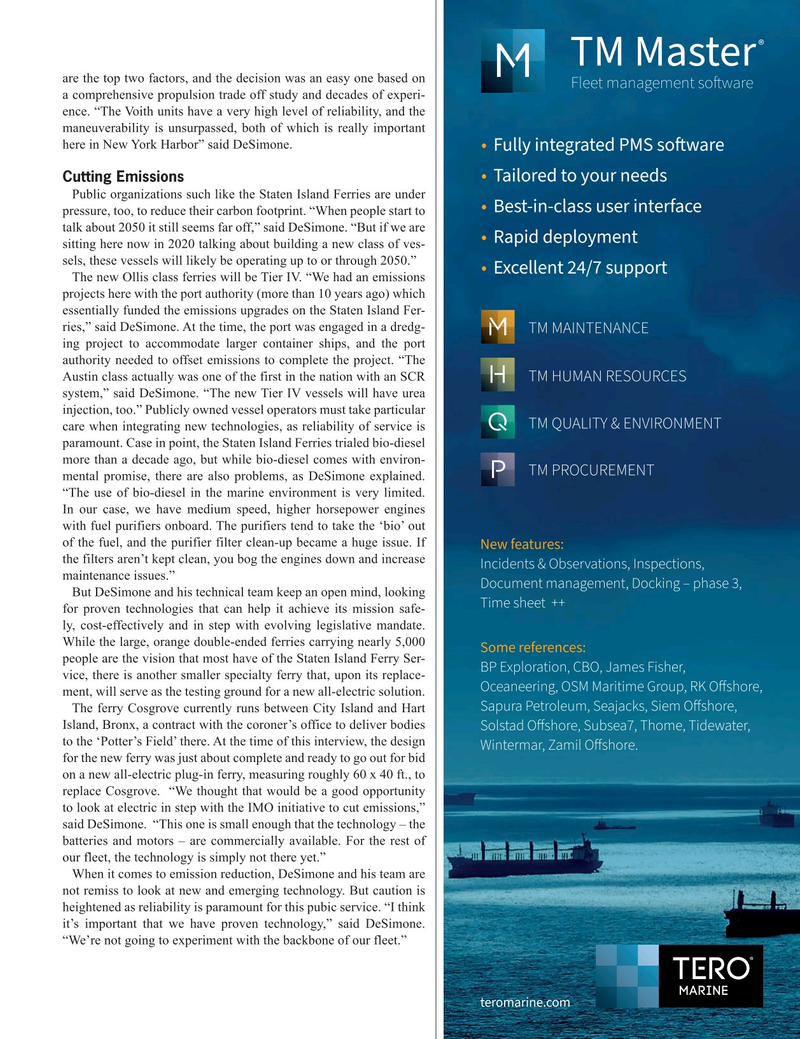
Page 39: of Maritime Reporter Magazine (March 2020)
Cruise Shipping Annual
Read this page in Pdf, Flash or Html5 edition of March 2020 Maritime Reporter Magazine
®
TM Master are the top two factors, and the decision was an easy one based on )""1*+$"*"+10,?4/" a comprehensive propulsion trade off study and decades of experi- ence. “The Voith units have a very high level of reliability, and the maneuverability is unsurpassed, both of which is really important here in New York Harbor” said DeSimone. • Fully integrated PMS sofware • Tailored to your needs
Cutting Emissions
Public organizations such like the Staten Island Ferries are under • Best-in-class user interface pressure, too, to reduce their carbon footprint. “When people start to talk about 2050 it still seems far off,” said DeSimone. “But if we are • Rapid deployment sitting here now in 2020 talking about building a new class of ves- sels, these vessels will likely be operating up to or through 2050.” • Excellent 24/7 support
The new Ollis class ferries will be Tier IV. “We had an emissions projects here with the port authority (more than 10 years ago) which essentially funded the emissions upgrades on the Staten Island Fer- ries,” said DeSimone. At the time, the port was engaged in a dredg-
TM MAINTENANCE ing project to accommodate larger container ships, and the port authority needed to offset emissions to complete the project. “The
Austin class actually was one of the first in the nation with an SCR
TM HUMAN RESOURCES system,” said DeSimone. “The new Tier IV vessels will have urea injection, too.” Publicly owned vessel operators must take particular
TM QUALITY & ENVIRONMENT care when integrating new technologies, as reliability of service is paramount. Case in point, the Staten Island Ferries trialed bio-diesel more than a decade ago, but while bio-diesel comes with environ-
TM PROCUREMENT mental promise, there are also problems, as DeSimone explained. “The use of bio-diesel in the marine environment is very limited.
In our case, we have medium speed, higher horsepower engines with fuel purifiers onboard. The purifiers tend to take the ‘bio’ out of the fuel, and the purifier filter clean-up became a huge issue. If
New features: the filters aren’t kept clean, you bog the engines down and increase
Incidents & Observations, Inspections, maintenance issues.”
Document management, Docking – phase 3,
But DeSimone and his technical team keep an open mind, looking
Time sheet ++ for proven technologies that can help it achieve its mission safe- ly, cost-effectively and in step with evolving legislative mandate.
While the large, orange double-ended ferries carrying nearly 5,000
Some references: people are the vision that most have of the Staten Island Ferry Ser-
BP Exploration, CBO, James Fisher, vice, there is another smaller specialty ferry that, upon its replace-
Oceaneering, OSM Maritime Group, RK Ofshore, ment, will serve as the testing ground for a new all-electric solution.
Sapura Petroleum, Seajacks, Siem Ofshore,
The ferry Cosgrove currently runs between City Island and Hart
Island, Bronx, a contract with the coroner’s office to deliver bodies
Solstad Ofshore, Subsea7, Thome, Tidewater, to the ‘Potter’s Field’ there. At the time of this interview, the design
Wintermar, Zamil Ofshore.
for the new ferry was just about complete and ready to go out for bid on a new all-electric plug-in ferry, measuring roughly 60 x 40 ft., to replace Cosgrove. “We thought that would be a good opportunity to look at electric in step with the IMO initiative to cut emissions,” said DeSimone. “This one is small enough that the technology – the batteries and motors – are commercially available. For the rest of our fleet, the technology is simply not there yet.”
When it comes to emission reduction, DeSimone and his team are not remiss to look at new and emerging technology. But caution is heightened as reliability is paramount for this pubic service. “I think it’s important that we have proven technology,” said DeSimone. “We’re not going to experiment with the backbone of our fleet.” teromarine.com
MR #3 (34-49).indd 39 3/5/2020 9:10:00 AM

 38
38

 40
40
